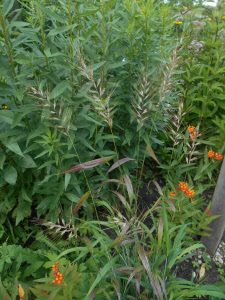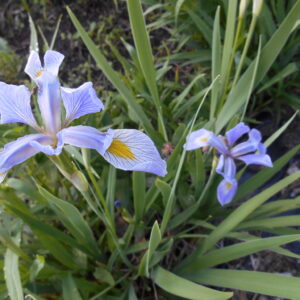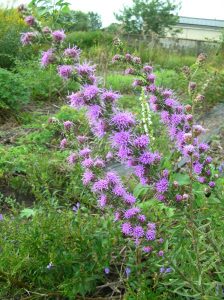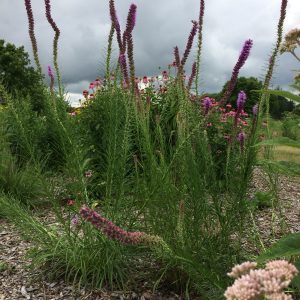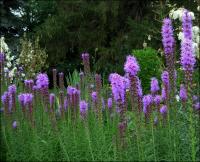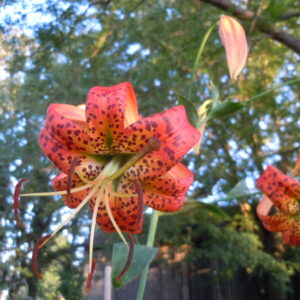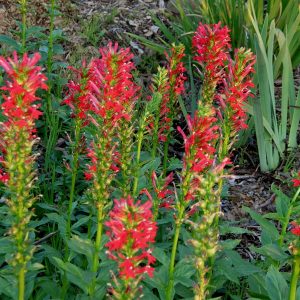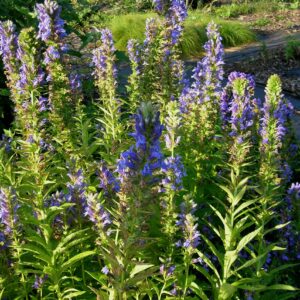Prairie Plants
Showing 49–56 of 81 results
-
Hystrix patula syn. Elymus hystris var. hystris Bottle brush grass Z 5-9
June thru fall bears 6” long spikes looking like bottle brushes
OUT OF STOCK
June thru fall bears 6” long spikes looking like bottle brushes.
Size: 2-3’ x 12-18”
Care: sun to part shade in dry to moist well-drained soil - tolerates dry shade
Native: Nova Scotia S to Virginia, W to ND and OK. Wisconsin native
Wildlife Value: Birds eat seedsHystrix from the Greek (‘hedgehog’) meaning “with spikes” or “bristly” describing the flowers and patula means “spreading.” Collected before 1794. In 1913 L H Bailey wrote, “sometimes used for lawn decoration and for borders.”
-
Iris versicolor Blue flag Z 3-9
Purple, lavender or blue flowers in June
Purple, lavender or blue flowers in June
Size: 36" x 12"
Care: sun, moist to moist well-drained soil
Native: Eastern United States, Wisconsin nativeIris is named after the Greek goddess who accompanied the souls of women to the Elysian Fields by way of the rainbow. Her footprints left flowers the colors of the rainbow. Iris means the eye of heaven. Omaha Indians used the roots topically to cure earaches. Other tribes applied a poultice to cure sores and bruises. Root is poisonous. Cultivated in gardens since the 1700’s.
-
Liatris aspera Rough blazing star Z 4-9
Feathery purple buttons along tall spikes August-October
OUT OF STOCK
Feathery purple buttons along tall spike in late summer: August-October
Size: 24”-30” x 12”-18”
Care: Sun in well-drained soil
Native: So. Canada, much of eastern 3/4th of U.S., Wisconsin Native
Wildlife Value: attract butterflies (favorite nectar for Monarchs and Buckeyes) & hummingbirds.Aspera is Latin meaning rough. 1st collected by Frenchman André Michaux (1746-1802) who spent 11 years in America collecting hundreds of new plants.
-
Liatris pycnostachya Prairie blazing star Z 3-9
Tall, erect, purplish- pink spike in August-September
OUT OF STOCK
Tall, erect, purplish- pink spike in August-September
Size: 4’ x 1-2’
Care: well-drained soil in full sun
Native: central & SE US
Wildlife Value: deer resistant, attracts birds, butterflies, and beesCollected by French planthunter Andre Michaux in 1795 on the prairies of Illinois. About 9 years later collected on the Lewis & Clark Expedition in South Dakota September 1804
-
Liatris spicata Blazing star, Gayfeather, Button snakeroot Z 3-8
Rosy purple spikes in July and August, a flower arranger’s dream
Rosy purple spikes in July and August, a flower arranger’s dream
Size: 2-3' x 18"
Care: Full sun in moist to well-drained soil.
Native: Eastern and southern U. S., Wisconsin native
Wildlife Value: favorite nectar source for Buckeye butterflies & host for caterpillars of Painted lady, Fritillaries, Skippers, Sulphurs, Coppers & Checkerspot butterflies.Native Americans used roots medicinally for backaches, colic, dropsy and to strengthen a weak heart. The Dakota recognized L. spicata as an indication “when the flower is blue-red that corn is good to eat.” Nicollet Diary, August 13, 1838. The dried root reputedly repelled moths from stored clothes. First collected by English naturalist Mark Catesby (1683-1749) and cultivated since 1732. Grown at America’s 1st botanic garden, Elgin Botanic Garden 1811.
-
Lilium superbum Meadow lily Z 4-8
Brilliant orange with purple spots, Turks’-cap type, reflexed petals (tepals), blooming in late summer to early fall.
Brilliant orange with purple spots, turks-cap lily with dramatic, swept-back petals blooming late summer to early fall. Slow to mature but when it does it bears up to 40 flowers on one plant.
Size: 10’ x 12”
Care: Sun in moist to moist-well-drained, acidic soil
Native: from VT to Fl & west to Mississippi River, Wisconsin nativeLilium was named for the Greek word for smooth, polished referring to its leaves. This collected before 1665. In his 1665 book, Flora, seu de Florum Cultura John Rea, nurseryman and author, called it the “Virginia Martagon.” Sold in America’s 1st plant catalog, Bartram’s Broadside, 1783. L.H. Bailey (1913): “The most magnificent and showy of native North American species, well worthy of extensive cultivation.”
-
Lobelia cardinalis Cardinal flower Z 3-9
Ruby, cardinal red tubes with an upper lip split in half and a lower lip like a pixie’s apron encircle the spike from August to October beckon hummingbirds to feed.
Ruby, cardinal red tubes with an upper lip split in half and a lower lip like a pixie’s apron encircle the spike from August to October beckon hummingbirds to feed.
Size: 3’ x 12”
Care: sun to part shade in fertile, moist soil. Moist soil important
Native: Canada to Texas, Wisconsin native.
Wildlife Value: attracts hummingbirds
Awards: Received England’s Royal Horticultural Society Award of Merit & Missouri Botanic Garden Plant of Merit.Cherokee cured stomach aches, worms, pain, fever, nose bleeds, rheumatism, headaches, colds, and croup with Lobelia. They used the root to treat syphilis. Other Natives and colonists used the plant to induce vomiting. At the end of a funeral, Meskwaki Indians threw the dried and pulverized plant into the grave. Meskwaki also chopped the roots and secretly put it in the food of “a quarrelsome pair.” Allegedly “this makes the pair love each other again.” Lobelia is named for Matthias L’Obel (1538-1616) French expatriate who immigrated to England and became physician to English King James I. Tradescant the Younger introduced this to European gardens when he sent it to England in 1637. Offered for sale in Bartram Garden’s 1783 Broadside. In 1749 Swedish botanist Peter Kalm wrote that Indians used five species of Lobelia to cure venereal disease, “an infallible art of curing it.” Grown by Washington at Mount Vernon and Thomas Jefferson at Monticello. Pressed specimen in Emily Dickinson’s herbarium.
-
Lobelia siphilitica Great lobelia Z 4-9
A striking, erect spike of sky to blueberry-blue blossoms. On top club-shaped buds, below trumpet-shapes, open flowers, made of a tube flaring open with the bottom divided into three, each segment pointed at the ends. From late summer to early fall.
A striking, erect spike of sky to blueberry-blue blossoms. On top club-shaped buds, below trumpet-shapes, open flowers, made of a tube flaring open with the bottom divided into three, each segment pointed at the ends. From late summer to early fall.
Size: 3' x 12"
Care: Full sun to part shade in moist to moist well-drained soil
Native: Connecticut to Wyoming, south to Texas then east to Georgia and all states in between, Wisconsin native.
Wildlife Value: attracts bumble bees, hummingbirds and some butterfliesLobelia is named for Matthias L’Obel (1538-1616) a French expatriate who emigrated to England and became physician to English King James I. Cherokee used the root to treat headaches, stomachaches, worms, nosebleeds, colds and syphilis. 1st collected by Rev. John Banister who moved to colonial Virginia in 1678. A gunman mistakenly shot and killed him while he collected plants. In 1749 Swedish botanist Peter Kalm wrote that Indians used five species of Lobelia to cure venereal disease, having “an infallible art of curing it.” According to John Bartram (1699-17760) “The learned Pehr Kalm (who gained the Knowledge of it from Colonel Johnson, who learned it of the Indians, who, after great Rewards bestowed on several of them, revealed the Secret to him) saith, That the Roots of this Plant cureth the Pox much more perfectly and easily than any mercurial Preparations, and is generally used by the Canada Indians, for the Cure of themselves“ (Better than mercury!) Oneidas considered this good medicine for distemper. Sioux treated bloat, diarrhea and dysentery as well as a love charm by adding powdered root to the food of the intended. Offered for sale in Bartram Garden’s 1783 Broadside, America’s 1st plant catalog.

